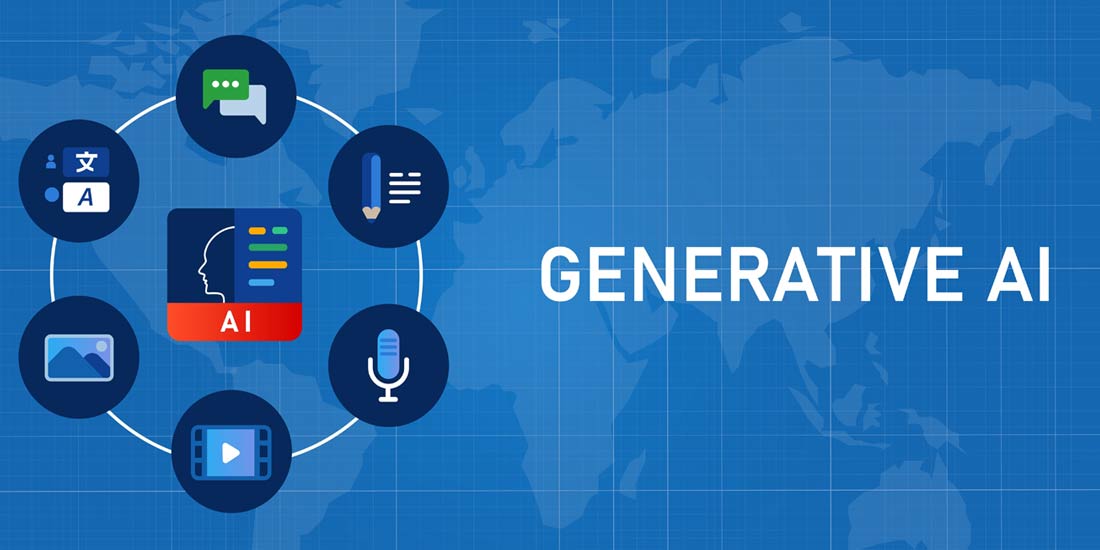Unlocking the Power of Generative and Language AI

Generative AI is artificial intelligence that uses deep learning algorithms to generate new content such as images, text, music, and even videos. This AI is capable of generating new, original data based on patterns and examples from existing data.
Models are trained on large datasets and learn to recognize patterns in the data. They then use these patterns to generate new, similar data that has not been seen before. For example, a generative AI model trained on a dataset of human faces could be used to generate new faces that look similar to real human faces but are not based on any specific individuals.
Generative AI is used by businesses and others for a wide range of applications. One of the most popular uses of generative AI is in the field of content creation. For example, generative AI models can be used to create new product descriptions, news articles, and even entire books. In the entertainment industry, generative AI can be used to create music, art, and special effects for movies and video games.
In my opinion, one of the most promising avenues is the use of generative AI to organize language data at scale and unlock the value of massive language data assets. Those assets may include emails, CRM, internal wikis, chat logs, or online reviews. By using deep learning algorithms to analyze and understand such unstructured text data at scale, AI can help companies convert their language data into more structured formats, making it easier to use in various analytical and operational processes.
Such an approach will help companies unlock insights that were previously hidden in unstructured language data. For example, a company may have a large collection of customer feedback emails that are difficult to analyze due to their unstructured nature. By using generative AI to convert this data into a structured format, companies can analyze sentiment, identify common themes, and gain a better understanding of customer needs and preferences. This can help them improve their products and services and create more targeted marketing campaigns, ultimately leading to increased revenue and customer satisfaction.
Generative AI is also used in fields such as medicine and science. For example, researchers can use generative AI to create new drug compounds or to simulate the behavior of molecules. In finance, generative AI can be used to generate new investment strategies or to identify potential market trends.
Generative AI has already made significant strides in many areas, and the potential for future developments is immense. One area where we can expect to see continued growth is in the field of text-to-video. With the ability to analyze vast amounts of text data and pair it with appropriate visuals, generative AI can help creators develop customized and immersive video content. For example, Meta has already announced a Make-A-Video project capable of generating a video out of text and static images.
In addition, we can expect to see continued advancements in generative AI for personalized medicine. With the ability to analyze vast amounts of patient data, generative AI can help doctors develop customized treatment plans that are tailored to each individual’s unique genetic and physiological makeup. This will lead to more effective treatments and better patient outcomes.
Furthermore, generative AI is set to transform the creative industry. With the ability to analyze existing works and generate new content that adheres to specific styles and aesthetics, generative AI has the potential to revolutionize music composition, visual art, and even writing.
Like Generative AI, Language AI is another subset of artificial intelligence, and it will also have a major role in transforming businesses. The two technologies are a bit different though in their scope and focus.
While Generative AI is a broad category of AI that includes all systems capable of generating new data and involves using machine learning algorithms, Language AI specifically refers to AI models that are trained on language data, such as text and speech, to understand and generate human-like language. Language AI models can be trained for a variety of tasks, such as language translation, speech recognition, text summarization, and question-answering.
While Generative AI can include Language AI models as one of its applications, Language AI is a narrower field that focuses exclusively on language-related tasks.
So simply put, Generative AI is a broad category of AI that includes all systems capable of generating new data, while language AI is a specific subset of generative AI that is focused on understanding and generating natural language.
Overall, the future of both Generative AI and Language AI are full of promise. As technology continues to advance, we can expect to see continued growth and innovation in this field, with new applications and use cases emerging on a regular basis. It is exciting to be part of and to also experience how both AI technologies will continue to evolve and make impactful strides in so many various industries.
About the Author

Amit Ben is co-founder & CEO of One AI. Amit’s passion for language technologies started at an early age, when he was only 5 years old. He started coding on an XT machine and since then, he’s been on a mission to make human-level language AI accessible to all. Amit co-founded NanRep, sold it to LogMeIn (LOGM) and then joined LogMeIn to lead its AI lab, developing the AI tech that powers products such as GoToMeeting and LastPass. When Francisco Partners acquired LogMeIn it was time to hit the entrepreneurial road again and continue to fulfill his mission to make Language AI integral and natural in everyday life – and he founded One AI.
Sign up for the free insideBIGDATA newsletter.
Join us on Twitter: https://twitter.com/InsideBigData1
Join us on LinkedIn: https://www.linkedin.com/company/insidebigdata/
Join us on Facebook: https://www.facebook.com/insideBIGDATANOW
